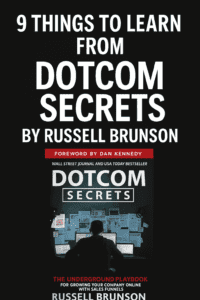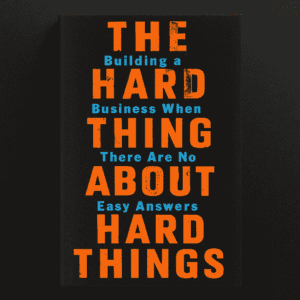The E-Myth Revisited by Michael E. Gerber is a bestselling business book that helps small business owners build a company that works, even when they’re not around.
The story around the book is something like this…
Gerber consulted a baker who loved baking but hated everything else that came with running a bakery. She was exhausted, confused, and drowning in work.
She had built herself a job, not a business. He saw this pattern over and over. And he wrote something about it.
The ideas are still very relevant today.
For example, you’re great at what you do. You launch a side hustle. But soon you’re stuck doing everything. You work longer hours than you did at your 9-to-5.
This book shows you how to stop that.
You’ll learn how to build systems, delegate tasks, and stop your business from running your life.
Let’s unpack 9 key lessons.
Table of Contents
Detailed Summary of The E-Myth Revisited by Michael E. Gerber
“Most small businesses fail not because their owners aren’t skilled, but because they try to run the whole show themselves.” — Michael E. Gerber.
In The E-Myth Revisited by Michael E. Gerber, he explains why most small businesses crash and burn, and what you can do to avoid that.
He says the biggest trap is believing that being good at something means you’re ready to start a business doing it. You’re not. That’s the E-Myth.
You might be a great baker, designer, or coach. But if you try to do everything yourself, your business will suck the life out of you. You’ll feel like you left your boss only to create a worse one — yourself.
Gerber breaks down three roles inside every business:
- The entrepreneur dreams.
- The manager plans.
- The technician does the work.
You need all three. Most people only act as the technician.
He shows you how to build systems so your business can grow without depending on you. He teaches the franchise model — like McDonald’s — where everything is clear, repeatable, and scalable.
You’ll learn to:
- Document your process.
- Build systems anyone can follow.
- Train people to run your business for you.
This book forces you to ask the hard questions:
What do you really want?
What does your business need to look like to support that?
If you want a business that frees you instead of trapping you, The E-Myth Revisited by Michael E. Gerber is your starting point.

9 Lessons from The E-Myth Revisited by Michael E. Gerber
“If your business depends on you, you don’t own a business. You have a job. And it’s the worst job in the world.” — Michael E. Gerber.
That quote hits hard, especially when you’re pulling 14-hour days trying to keep your business alive. If you’ve ever felt stuck building a side hustle that’s now running your life, you’re not alone. Gerber wrote The E-Myth Revisited for people like you.
Here are 9 straight-to-the-point lessons from the book to help you break free.
1. You’re not just one person in your business. You’re three.
He says every small business owner has three personalities fighting inside them:
- The entrepreneur dreams and plans the future.
- The manager organizes and keeps order.
- The technician does the actual work.
You’re probably stuck in technician mode. You’re doing all the work. That’s why you feel burned out. To grow your business, these three roles must work together.
Ask yourself:
- Am I only doing the work?
- Who’s planning the future of this business?
- Who’s managing the systems?
2. Being good at something doesn’t mean you’re ready to build a business around it.

This is what Gerber calls the E-Myth: the Entrepreneurial Myth.
You’re a great designer, coach, writer, or baker. So you start a business. But knowing the craft doesn’t mean you know how to run a business that sells that craft.
You don’t need another course in your field. You need to learn how to build a business system.
3. Your business has to go through painful growth stages. Don’t run away when it gets hard.
Gerber breaks this down into three phases:
- Infancy (Technician phase): You do everything.
- Adolescence (Manager phase): You start hiring and building structure.
- Maturity (Entrepreneur phase): Your business runs on systems.
Most people quit at adolescence. It’s the messiest phase. You start hiring, trusting people, and realizing your business is not ready for scale.
If you quit when things get hard, you never reach maturity.
4. Work on your business, not in it.
This one’s popular, but most people still ignore it.
He means your job isn’t to bake cakes, fix code, or write blog posts. Your job is to build systems that let other people do that work consistently.

Systems give you freedom. They create repeatable results. You can’t scale without them.
Start by listing the tasks you do every day.
Then ask:
- Can this be automated?
- Can I teach someone else to do it?
- Is this task even necessary?
5. Build your business like it’s a franchise — even if you never plan to sell it.
Gerber uses McDonald’s as the example.
Every McDonald’s looks, feels, and operates the same because it runs on systems. The staff changes, but the results don’t.
He says your business should work like that too. Create a business that:
- Runs without your constant presence
- Has written processes and standards
- Delivers consistent results to every customer
Even if you never sell it, thinking like a franchise owner forces you to organize everything.
6. Build systems around low-skill tasks so anyone can do them.
Don’t make your business so complex that only “experienced people” can run it.
Instead:
- Document the work
- Simplify your processes
- Break tasks into steps
- Create checklists

This helps you hire people who are trainable, even if they’re new.
Hiring experienced people with strong opinions on “how things should be done” creates friction. You want people who are open, coachable, and excited to follow your system.
7. Quantify everything.
It’s not enough to try a new tactic. You need to measure its results.
He gives a funny but true example.
Let’s say you wear a blue suit for a week and close more sales. Great. Now test that again. Track how many calls you took, how many sales you made, what changed.
If the numbers improve, that’s a signal. Quantification helps you know what’s working, so you can repeat it.
Most business owners don’t do this. You should.
8. Orchestrate success. Don’t leave it to chance.
Once something works — a script, an onboarding sequence, a sales page — document it and repeat it.
Same words. Same process. Same timing.

Orchestration means doing it the same way, every time, so the results are consistent. It removes decision fatigue. It gives your team confidence.
If you let people do things “how they feel,” you create chaos. That’s how standards drop. That’s how customers leave.
So once you find what works, lock it in.
9. Define your “primary aim” before you do anything else.
This is about your life, not just your business.
Gerber asks: what do you want your life to look like?
That goal becomes your “primary aim.” Then your business becomes the tool to help you get there.
So stop building your business randomly. Design it backward from your ideal life.
Questions to ask:
- Do you want freedom or do you want to manage people?
- Do you want to sell eventually or keep it forever?
- What would your ideal day look like?
If your business doesn’t support your life, you’re building the wrong business.
You don’t need to feel stuck running a business that exhausts you.
You need systems. You need structure. You need clarity.
And The E-Myth Revisited by Michael E. Gerber gives you a simple roadmap to do that.
He doesn’t just tell you to hustle. He teaches you how to build a real business that works without you.
If you’re serious about creating a business that gives you freedom and not just more stress, the book would be your go-to resource.
Wrapping Up
If you’ve been grinding non-stop but still feel stuck, The E-Myth Revisited by Michael E. Gerber gives you the clarity you need. He shows you how to stop being the worker and start being the builder.
You don’t need to do more. You need to do it differently. Start designing systems, not just doing tasks. Your business should work for you, not the other way around.
If this shifted how you think about business, you’ll love what’s in Think and Grow Rich. It builds on this mindset and helps you reshape your beliefs around money and success.




Pingback: Start With Why by Simon Sinek (9 Important Lessons Plus Book Summary)